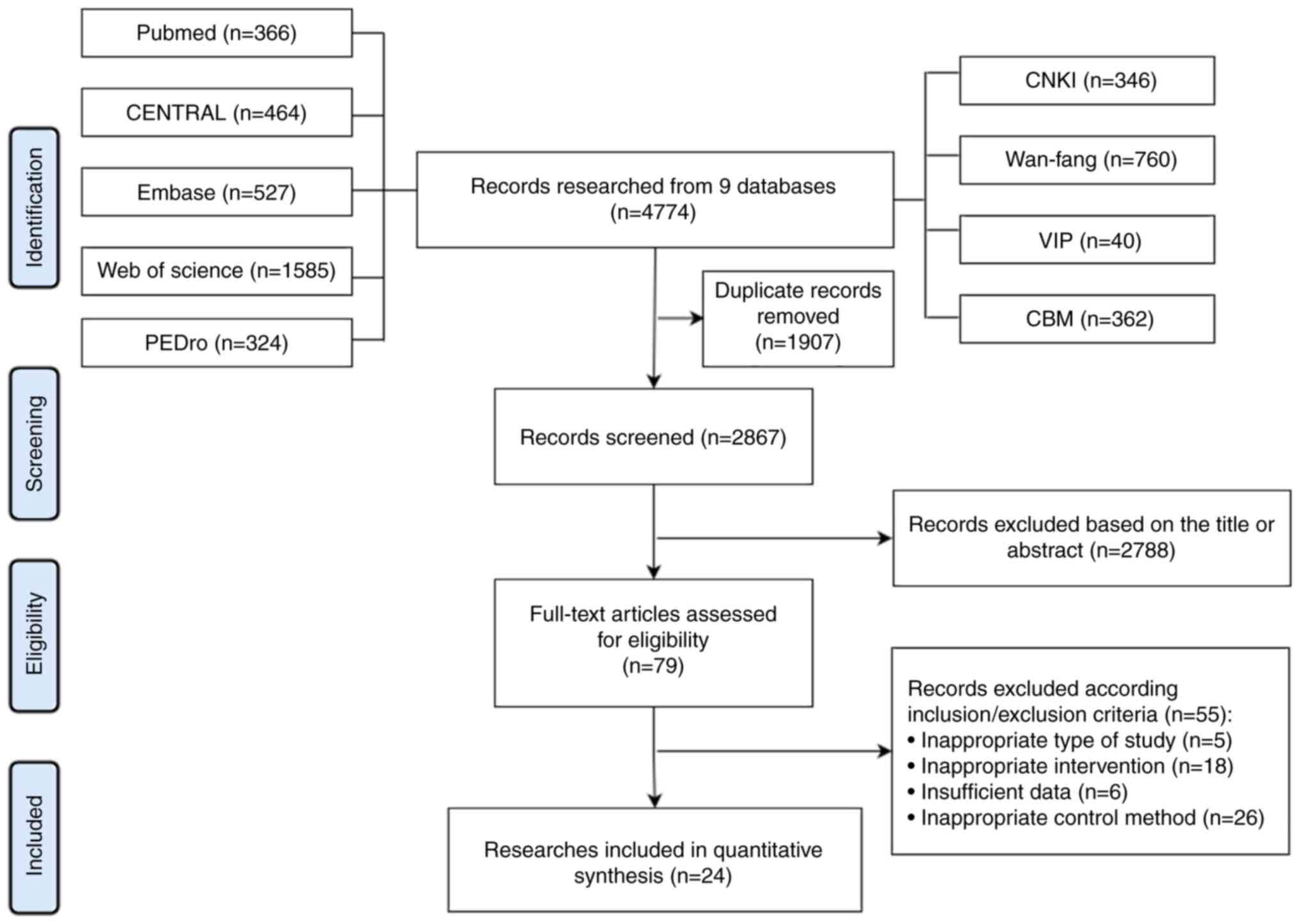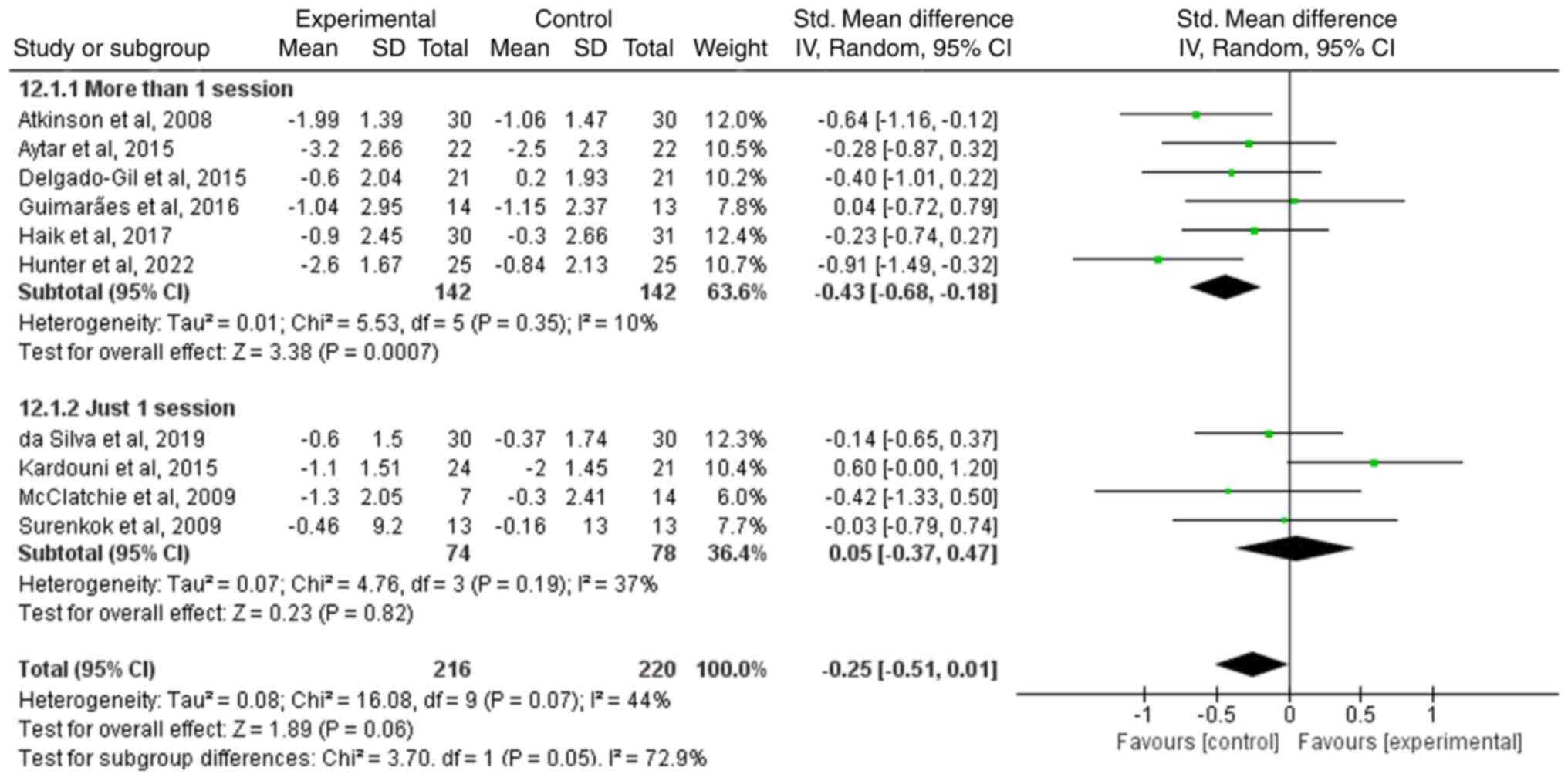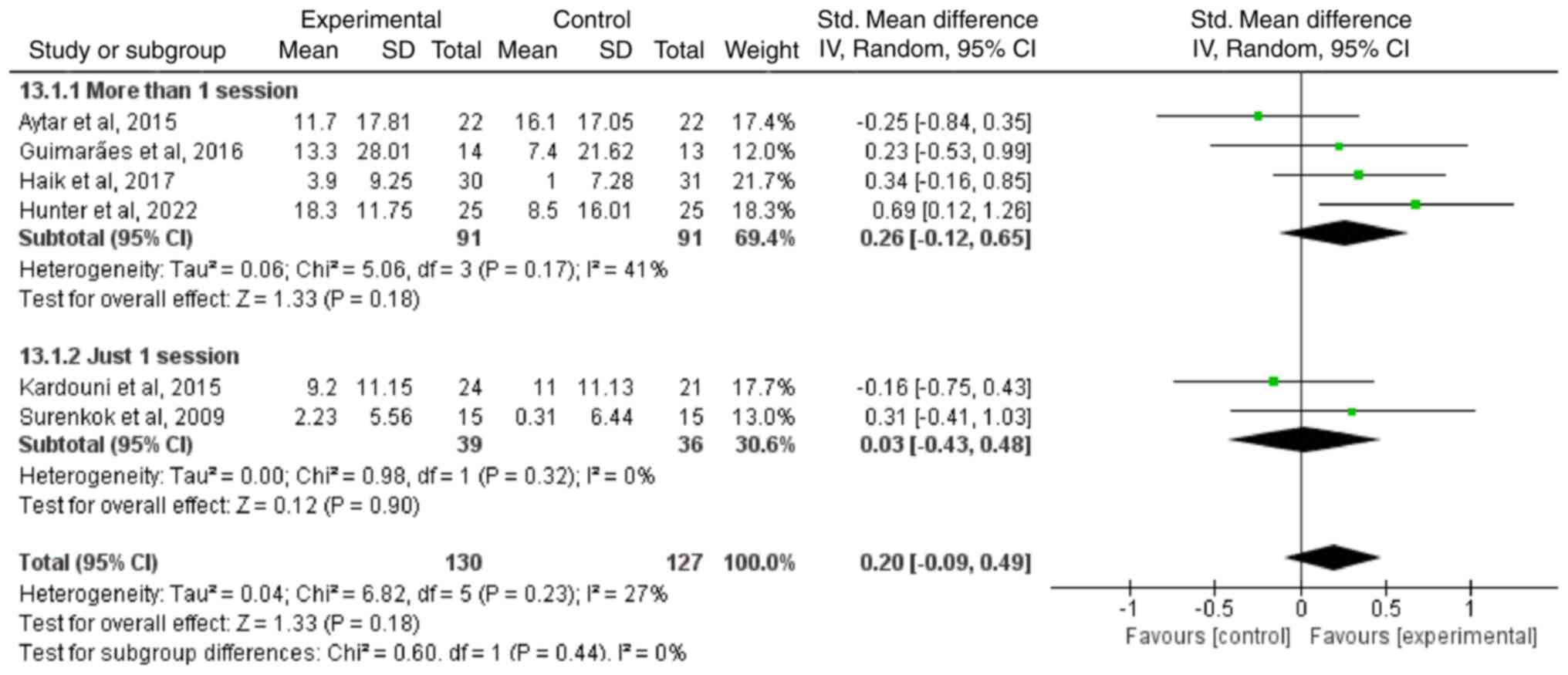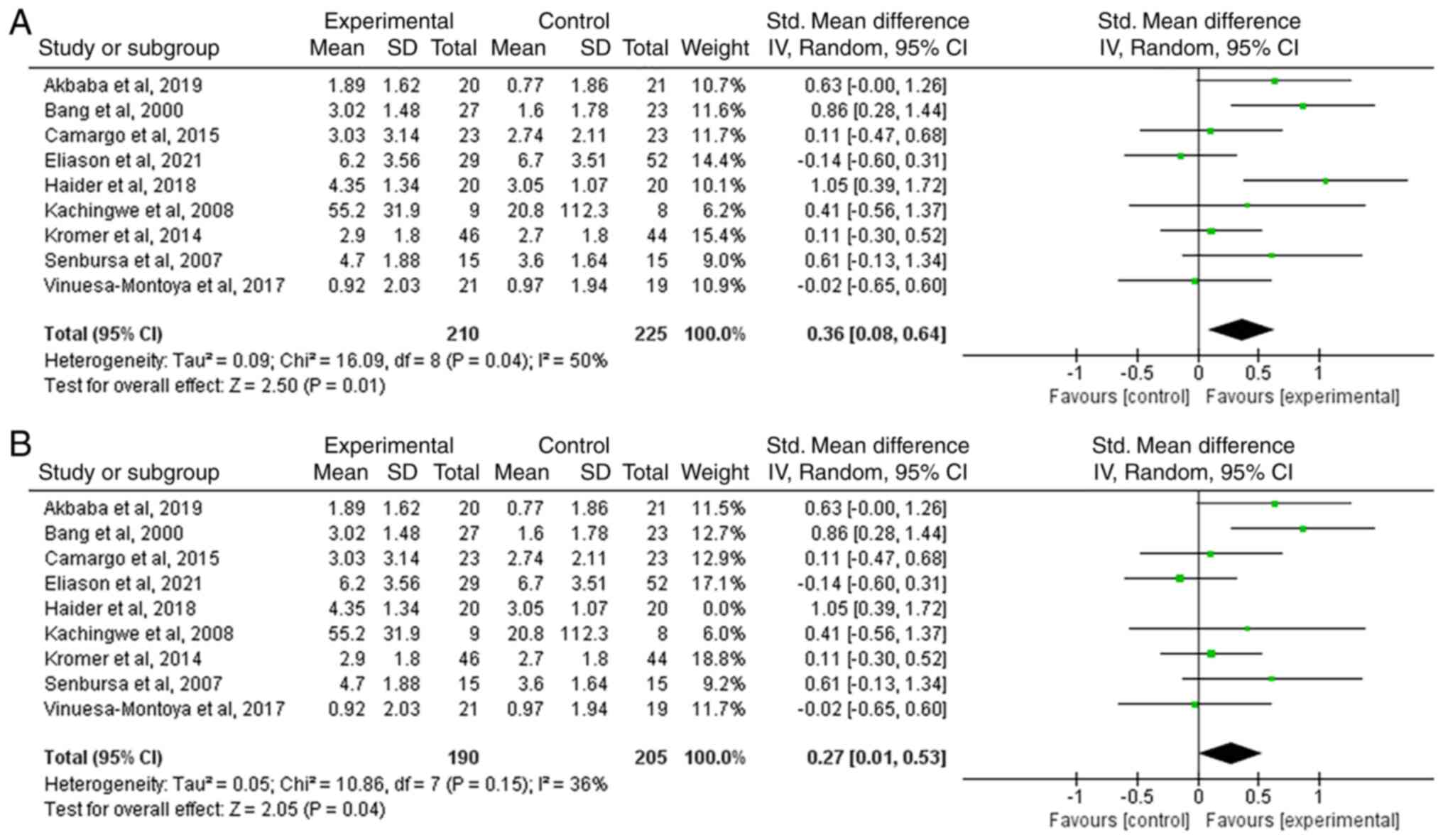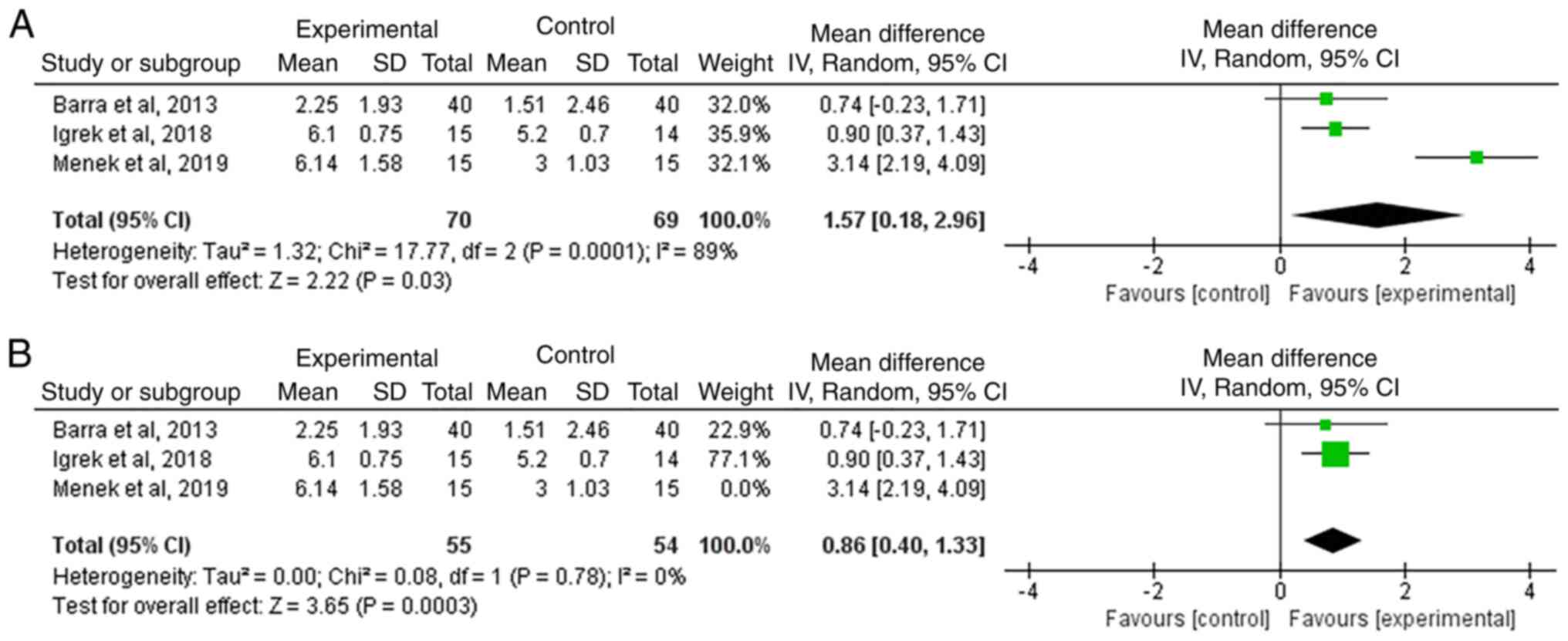|
1
|
Lewis J, Mccreesh K, Roy JS and Ginn K:
Rotator cuff tendinopathy: Navigating the diagnosis-management
conundrum. J Orthop Sports Phys Ther. 45:923–937. 2015.PubMed/NCBI View Article : Google Scholar
|
|
2
|
Weber S and Chahal J: Management of
rotator cuff injuries. J Am Acad Orthop Surg. 28:e193–e201.
2020.PubMed/NCBI View Article : Google Scholar
|
|
3
|
Sambandam SN, Khanna V, Gul A and
Mounasamy V: Rotator cuff tears: An evidence based approach. World
J Orthop. 6:902–918. 2015.PubMed/NCBI View Article : Google Scholar
|
|
4
|
Godeau D, Fadel M and Descatha A: Factors
associated with limitations in daily life and at work in a
population with shoulder pain. BMC Musculoskelet Disord.
23(777)2022.PubMed/NCBI View Article : Google Scholar
|
|
5
|
Consigliere P, Haddo O, Levy O and Sforza
G: Subacromial impingement syndrome: management challenges. Orthop
Res Rev. 10:83–91. 2018.PubMed/NCBI View Article : Google Scholar
|
|
6
|
Ulack C, Suarez J, Brown L, Ring D,
Wallace S and Teisberg E: What are people that seek care for
rotator cuff tendinopathy experiencing in their daily life? J
Patient Exp. 9(23743735211069811)2022.PubMed/NCBI View Article : Google Scholar
|
|
7
|
Osborne JD, Gowda AL, Wiater B and Wiater
JM: Rotator cuff rehabilitation: Current theories and practice.
Phys Sportsmed. 44:85–92. 2016.PubMed/NCBI View Article : Google Scholar
|
|
8
|
Lewis J: Rotator cuff related shoulder
pain: Assessment, management and uncertainties. Man Ther. 23:57–68.
2016.PubMed/NCBI View Article : Google Scholar
|
|
9
|
Zhou D, Zhou F, Sheng S, Wei Y, Chen X and
Su J: Intra-articular nanodrug delivery strategies for treating
osteoarthritis. Drug Discov Today. 28(103482)2023.PubMed/NCBI View Article : Google Scholar
|
|
10
|
Mi CH, Qi XY, Ding YW, Zhou J, Dao JW and
Wei DX: Recent advances of medical polyhydroxyalkanoates in
musculoskeletal system. Biomater Transl. 4:234–247. 2023.PubMed/NCBI View Article : Google Scholar
|
|
11
|
Sun S, Liu H, Hu Y, Wang Y, Zhao M, Yuan
Y, Han Y, Jing Y, Cui J, Ren X, et al: Selection and identification
of a novel ssDNA aptamer targeting human skeletal muscle. Bioact
Mater. 20:166–178. 2022.PubMed/NCBI View Article : Google Scholar
|
|
12
|
Ying J, Yu H, Cheng L, Li J, Wu B, Song L,
Yi P, Wang H, Liu L and Zhao D: Research progress and clinical
translation of three-dimensional printed porous tantalum in
orthopaedics. Biomater Transl. 4:166–179. 2023.PubMed/NCBI View Article : Google Scholar
|
|
13
|
Li J, Zhang H, Han Y, Hu Y, Geng Z and Su
J: Targeted and responsive biomaterials in osteoarthritis.
Theranostics. 13:931–954. 2023.PubMed/NCBI View Article : Google Scholar
|
|
14
|
Desjardins-Charbonneau A, Roy JS, Dionne
CE, Frémont P, MacDermid JC and Desmeules F: The efficacy of manual
therapy for rotator cuff tendinopathy: A systematic review and
meta-analysis. J Orthop Sports Phys Ther. 45:330–350.
2015.PubMed/NCBI View Article : Google Scholar
|
|
15
|
Steuri R, Sattelmayer M, Elsig S, Kolly C,
Tal A, Taeymans J and Hilfiker R: Effectiveness of conservative
interventions including exercise, manual therapy and medical
management in adults with shoulder impingement: A systematic review
and meta-analysis of RCTs. Br J Sports Med. 51:1340–1347.
2017.PubMed/NCBI View Article : Google Scholar
|
|
16
|
Page MJ, Green S, McBain B, Surace SJ,
Deitch J, Lyttle N, Mrocki MA and Buchbinder R: Manual therapy and
exercise for rotator cuff disease. Cochrane Database Syst Rev.
2016(CD012224)2016.PubMed/NCBI View Article : Google Scholar
|
|
17
|
Akbaba YA, Mutlu EK, Altun S, Turkmen E,
Birinci T and Celik D: The effectiveness of trigger point treatment
in rotator cuff pathology: A randomized controlled double-blind
study. J Back Musculoskelet Rehabil. 32:519–527. 2019.PubMed/NCBI View Article : Google Scholar
|
|
18
|
Eliason A, Harringe M, Engström B and
Werner S: Guided exercises with or without joint mobilization or no
treatment in patients with subacromial pain syndrome: A clinical
trial. J Rehabil Med. 53(jrm00190)2021.PubMed/NCBI View Article : Google Scholar
|
|
19
|
Haider R, Bashir MS, Adeel M, Ijaz MJ and
Ayub A: Comparison of conservative exercise therapy with and
without maitland thoracic manipulative therapy in patients with
subacromial pain: Clinical trial. J Pak Med Assoc. 68:381–387.
2018.PubMed/NCBI
|
|
20
|
Hunter DJ, Rivett DA, Mckiernan S, Luton R
and Snodgrass SJ: Thoracic manual therapy improves pain and
disability in individuals with shoulder impingement syndrome
compared with placebo: A randomized controlled trial with 1-year
follow-up. Arch Phys Med Rehabil. 103:1533–1543. 2022.PubMed/NCBI View Article : Google Scholar
|
|
21
|
İğrek A and Çolak TK: Comparison of the
effectiveness of proprioceptive neuromuscular facilitation
exercises and shoulder mobilization patients with subacromial
impingement syndrome: A randomized clinical trial. J Bodyw Mov
Ther. 30:42–52. 2022.PubMed/NCBI View Article : Google Scholar
|
|
22
|
Menek B, Tarakci D and Algun ZC: The
effect of Mulligan mobilization on pain and life quality of
patients with rotator cuff syndrome: A randomized controlled trial.
J Back Musculoskelet Rehabil. 32:171–178. 2019.PubMed/NCBI View Article : Google Scholar
|
|
23
|
Park SJ and Kim SH and Kim SH: Effects of
thoracic mobilization and extension exercise on thoracic alignment
and shoulder function in patients with subacromial impingement
syndrome: A randomized controlled pilot study. Healthcare (Basel).
8:316–326. 2020.PubMed/NCBI View Article : Google Scholar
|
|
24
|
Sharma S, Ejaz Hussain M and Sharma S:
Effects of exercise therapy plus manual therapy on muscle activity,
latency timing and SPADI score in shoulder impingement syndrome.
Complement Ther Clin Pract. 44(101390)2021.PubMed/NCBI View Article : Google Scholar
|
|
25
|
Silva ACD, Santos GM, Marques CMDG and
Marques JLB: Immediate effects of spinal manipulation on shoulder
motion range and pain in individuals with shoulder pain: A
randomized trial. J Chiropr Med. 18:19–26. 2019.PubMed/NCBI View Article : Google Scholar
|
|
26
|
Hutton B, Salanti G, Caldwell DM, Chaimani
A, Schmid CH, Cameron C, Ioannidis JP, Straus S, Thorlund K, Jansen
JP, et al: The PRISMA extension statement for reporting of
systematic reviews incorporating network meta-analyses of health
care interventions: Checklist and explanations. Ann Intern Med.
162:777–784. 2015.PubMed/NCBI View
Article : Google Scholar
|
|
27
|
Verhagen AP, De Vet HC, De Bie RA, Kessels
AG, Boers M, Bouter LM and Knipschild PG: The Delphi list: A
criteria list for quality assessment of randomized clinical trials
for conducting systematic reviews developed by Delphi consensus. J
Clin Epidemiol. 51:1235–1241. 1998.PubMed/NCBI View Article : Google Scholar
|
|
28
|
Macedo LG, Elkins MR, Maher CG, Moseley
AM, Herbert RD and Sherrington C: There was evidence of convergent
and construct validity of physiotherapy evidence database quality
scale for physiotherapy trials. J Clin Epidemiol. 63:920–925.
2010.PubMed/NCBI View Article : Google Scholar
|
|
29
|
Maher CG, Sherrington C, Herbert RD,
Moseley AM and Elkins M: Reliability of the PEDro scale for rating
quality of randomized controlled trials. Phys Ther. 83:713–721.
2003.PubMed/NCBI
|
|
30
|
Sherrington C, Herbert RD, Maher CG and
Moseley AM: PEDro. A database of randomized trials and systematic
reviews in physiotherapy. Man Ther. 5:223–226. 2000.PubMed/NCBI View Article : Google Scholar
|
|
31
|
Karanasios S, Tsamasiotis GK, Michopoulos
K, Sakellari V and Gioftsos G: Clinical effectiveness of shockwave
therapy in lateral elbow tendinopathy: Systematic review and
meta-analysis. Clin Rehabil. 35:1383–1398. 2021.PubMed/NCBI View Article : Google Scholar
|
|
32
|
Jiménez-Del-Barrio S, Cadellans-Arróniz A,
Ceballos-Laita L, Estébanez-de-Miguel E, López-de-Celis C,
Bueno-Gracia E and Pérez-Bellmunt A: The effectiveness of manual
therapy on pain, physical function, and nerve conduction studies in
carpal tunnel syndrome patients: A systematic review and
meta-analysis. Int Orthop. 46:301–312. 2022.PubMed/NCBI View Article : Google Scholar
|
|
33
|
Siddall B, Ram A, Jones MD, Booth J,
Perriman D and Summers SJ: Short-term impact of combining pain
neuroscience education with exercise for chronic musculoskeletal
pain: A systematic review and meta-analysis. Pain. 163:e20–e30.
2022.PubMed/NCBI View Article : Google Scholar
|
|
34
|
Hahne AJ, Ford JJ and McMeeken JM:
Conservative management of lumbar disc herniation with associated
radiculopathy: A systematic review. Spine (Phila Pa 1976).
35:E488–E504. 2010.PubMed/NCBI View Article : Google Scholar
|
|
35
|
Slater SL, Ford JJ, Richards MC, Taylor
NF, Surkitt LD and Hahne AJ: The effectiveness of sub-group
specific manual therapy for low back pain: A systematic review. Man
Ther. 17:201–212. 2012.PubMed/NCBI View Article : Google Scholar
|
|
36
|
Higgins JPT, Thompson SG, Deeks JJ and
Altman DG: Measuring inconsistency in meta-analyses. BMJ.
327:557–560. 2003.PubMed/NCBI View Article : Google Scholar
|
|
37
|
DerSimonian R and Laird N: Meta-analysis
in clinical trials. Control Clin Trials. 7:177–188. 1986.PubMed/NCBI View Article : Google Scholar
|
|
38
|
Atkinson M, Matthews R, Brantingham JW,
Globe G, Cassa T, Bonnefin D and Korporaal C: A randomized
controlled trial to assess the efficacy of shoulder manipulation
versus placebo in the treatment of shoulder pain due to rotator
cuff tendinopathy. J Am Chiropr Assoc. 45:11–26. 2008.
|
|
39
|
Aytar A, Baltaci G, Uhl TL, Tuzun H, Oztop
P and Karatas M: The effects of scapular mobilization in patients
with subacromial impingement syndrome: A randomized, double-blind,
placebo-controlled clinical trial. J Sport Rehabil. 24:116–129.
2015.PubMed/NCBI View Article : Google Scholar
|
|
40
|
Delgado-Gil JA, Prado-Robles E,
Rodrigues-de-Souza DP, Cleland JA, Fernández-de-las-Peñas C and
Alburquerque-Sendín F: Effects of mobilization with movement on
pain and range of motion in patients with unilateral shoulder
impingement syndrome: A randomized controlled trial. J Manipulative
Physiol Ther. 38:245–252. 2015.PubMed/NCBI View Article : Google Scholar
|
|
41
|
Guimarães JF, Salvini TF, Siqueira AL Jr,
Ribeiro IL, Camargo PR and Alburquerque-Sendín F: Immediate effects
of mobilization with movement vs sham technique on range of motion,
strength, and function in patients with shoulder impingement
syndrome: Randomized clinical trial. J Manipulative Physiol Ther.
39:605–615. 2016.PubMed/NCBI View Article : Google Scholar
|
|
42
|
Haik MN, Alburquerque-Sendin F and Camargo
PR: Short-term effects of thoracic spine manipulation on shoulder
impingement syndrome: A randomized controlled trial. Arch Phys Med
Rehabil. 98:1594–1605. 2017.PubMed/NCBI View Article : Google Scholar
|
|
43
|
Kardouni JR, Pidcoe PE, Shaffer SW,
Finucane SD, Cheatham SA, Sousa CO and Michener LA: Thoracic spine
manipulation in individuals with subacromial impingement syndrome
does not immediately alter thoracic spine kinematics, thoracic
excursion, or scapular kinematics: A randomized controlled trial. J
Orthop Sports Phys Ther. 45:527–538. 2015.PubMed/NCBI View Article : Google Scholar
|
|
44
|
McClatchie L, Laprade J, Martin S, Jaglal
SB, Richardson D and Agur A: Mobilizations of the asymptomatic
cervical spine can reduce signs of shoulder dysfunction in adults.
Man Ther. 14:369–374. 2009.PubMed/NCBI View Article : Google Scholar
|
|
45
|
Surenkok O, Aytar A and Baltaci G: Acute
effects of scapular mobilization in shoulder dysfunction: A
double-blind randomized placebo-controlled trial. J Sport Rehabil.
18:493–501. 2009.PubMed/NCBI View Article : Google Scholar
|
|
46
|
Bang MD and Deyle GD: Comparison of
supervised exercise with and without manual physical therapy for
patients with shoulder impingement syndrome. J Orthop Sports Phys
Ther. 30:126–137. 2000.PubMed/NCBI View Article : Google Scholar
|
|
47
|
Camargo PR, Alburouerque-Sendin F, Avila
MA, Haik MN, Vieira A and Salvini TF: Effects of stretching and
strengthening exercises, with and without manual therapy, on
scapular kinematics, function, and pain in individuals with
shoulder impingement: A randomized controlled trial. J Orthop
Sports Phys Ther. 45:984–997. 2015.PubMed/NCBI View Article : Google Scholar
|
|
48
|
Kachingwe AF, Phillips B, Sletten E and
Plunkett SW: Comparison of manual therapy techniques with
therapeutic exercise in the treatment of shoulder impingement: A
randomized controlled pilot clinical trial. J Man Manip Ther.
16:238–247. 2008.PubMed/NCBI View Article : Google Scholar
|
|
49
|
Kromer TO, de Bie RA and Bastiaenen CH:
Effectiveness of physiotherapy and costs in patients with clinical
signs of shoulder impingement syndrome: One-year follow-up of a
randomized controlled trial. J Rehabil Med. 46:1029–1036.
2014.PubMed/NCBI View Article : Google Scholar
|
|
50
|
Senbursa G, Baltaci G and Atay A:
Comparison of conservative treatment with and without manual
physical therapy for patients with shoulder impingement syndrome: A
prospective, randomized clinical trial. Knee Surg Sports Traumatol
Arthrosc. 15:915–921. 2007.PubMed/NCBI View Article : Google Scholar
|
|
51
|
Vinuesa-Montoya S, Aguilar-Ferrándiz ME,
Matarán-Peñarrocha GA, Fernández-Sánchez M, Fernández-Espinar EM
and Castro-Sánchez AM: A preliminary randomized clinical trial on
the effect of cervicothoracic manipulation plus supervised
exercises vs a home exercise program for the treatment of shoulder
impingement. J Chiropr Med. 16:85–93. 2017.PubMed/NCBI View Article : Google Scholar
|
|
52
|
Barra López ME, López de Celis C,
Fernández Jentsch G, Raya de Cárdenas L, Lucha López MO and Tricás
Moreno JM: Effectiveness of diacutaneous fibrolysis for the
treatment of subacromial impingement syndrome: A randomised
controlled trial. Man Ther. 18:418–424. 2013.PubMed/NCBI View Article : Google Scholar
|
|
53
|
Haas M, Bronfort G, Evans R, Schulz C,
Vavrek D, Takaki L, Hanson L, Leininger B and Neradilek MB:
Dose-response and efficacy of spinal manipulation for care of
cervicogenic headache: A dual-center randomized controlled trial.
Spine J. 18:1741–1754. 2018.PubMed/NCBI View Article : Google Scholar
|
|
54
|
Sturman S and Killingback C: Is there a
dose response relationship between soft tissue manual therapy and
clinical outcomes in fibromyalgia? J Bodyw Mov Ther. 24:141–153.
2020.PubMed/NCBI View Article : Google Scholar
|
|
55
|
Perlman AI, Ali A, Njike VY, Hom D, Davidi
A, Gould-Fogerite S, Milak C and Katz DL: Massage therapy for
osteoarthritis of the knee: A randomized dose-finding trial. PLoS
One. 7(e30248)2012.PubMed/NCBI View Article : Google Scholar
|
|
56
|
Kooijman M, Swinkels I, Van Dijk C, de
Bakker D and Veenhof C: Patients with shoulder syndromes in general
and physiotherapy practice: An observational study. BMC
Musculoskelet Disord. 14(128)2013.PubMed/NCBI View Article : Google Scholar
|
|
57
|
Eggelbusch M, Charlton BT, Bosutti A,
Ganse B, Giakoumaki I, Grootemaat AE, Hendrickse PW, Jaspers Y,
Kemp S, Kerkhoff TJ, et al: The impact of bed rest on human
skeletal muscle metabolism. Cell Rep Med. 5(101372)2024.PubMed/NCBI View Article : Google Scholar
|
|
58
|
Page MJ, Green S, Mrocki MA, Surace SJ,
Deitch J, McBain B, Lyttle N and Buchbinder R: Electrotherapy
modalities for rotator cuff disease. Cochrane Database Syst Rev.
2016(CD012225)2016.PubMed/NCBI View Article : Google Scholar
|















